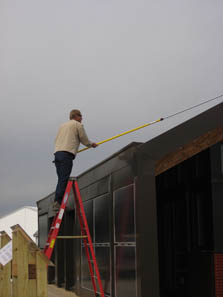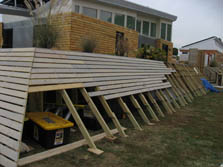
Click photo to view high-resolution image.

The maintenance of solar panels becomes critical on a cloudy day.
(Credit: Robin Ashmore/U.S. Department of Energy Solar Decathlon)

The University of Wisconsin at Milwaukee team repairs its house decking.
(Credit: Robin Ashmore/U.S. Department of Energy Solar Decathlon)
Solar Decathlon 2009
Daily Journal - October 14, 2009
Competition Enters the Final Stretch
Houses are closed to the public today—an important day in the competition because houses are monitored to test performance over a 24-hour period. By the end of the day, we will have a clearer idea of who has the most energy-efficient house and solar heating system. I say "heating" because it's so cold outside today! The temperatures started in the 40s and will climb only to the 50s.
Each house is instrumented with indoor temperature and humidity sensors. Teams must maintain an average indoor temperature of 72°F-76°F (22°C-24°C) and humidity of 40%-55%. Teams receive two points at every two-and-a-half-hour interval for maintaining readings within these limits. Right now, Team Ontario/BC leads the Comfort Zone contest, with the University of Illinois in second, Team Germany in third, and the University of Minnesota in fourth. Team California, currently the overall leader, holds 13th place in the Comfort Zone contest.
As the contest winds down in cloudy weather, most teams turn their strategic efforts to the Net Metering contest—worth a possible 150 points. Teams receive 100 points for producing as much energy as they consume over the contest-monitoring period, which ends at 10 p.m. tomorrow. The strategy of consuming the least amount of energy during the cloudy weather reduces the amount used or "purchased" from the Pepco grid. The team that produces the most excess electricity receives 50 points. The other team scores are then prorated based on their excess power compared with the team with the most. Right now, Team Germany is producing the most electricity and would receive all 50 points if the competition ended now. With only half as much electricity as Team Germany, the University of Illinois has the second most and would be awarded around 25 points. Team Ontario/BC is producing the third most excess energy. If the contest stopped now, these three teams would move ahead of Team California.
But a lot can happen between now and the finish. Tomorrow, the Lighting Contest jury announces its awards, and on Friday morning, the Engineering Contest jury makes its winners known, which always changes the point spread. Be sure to stay tuned!
